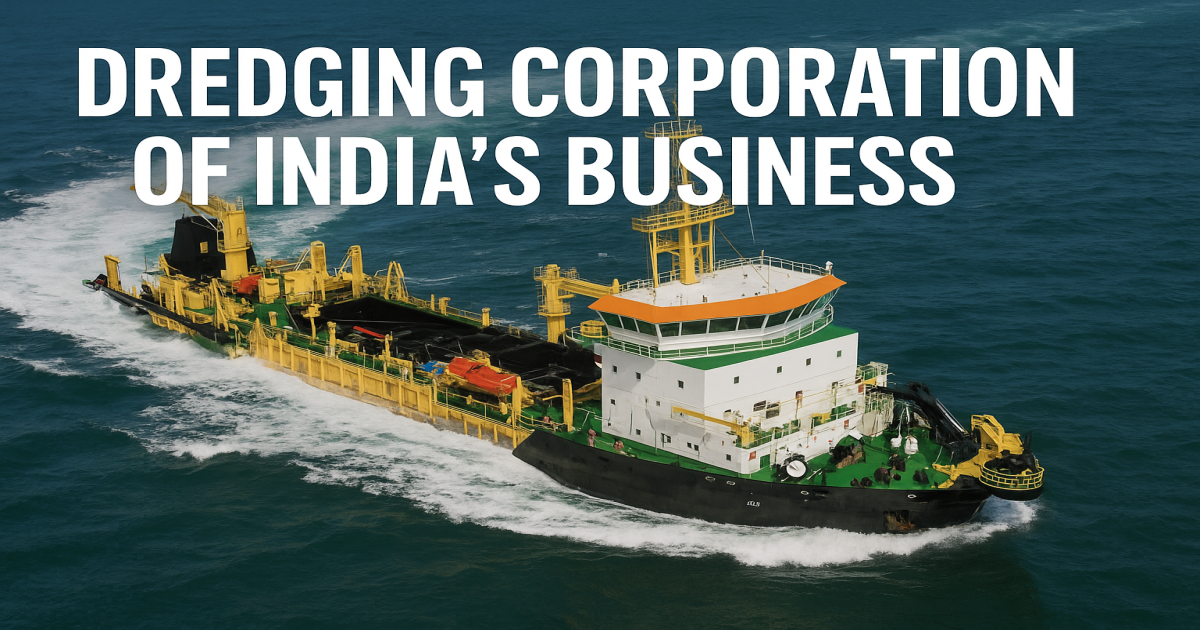Established in 1976, Dredging Corporation of India Limited (DCI) plays a vital role in maintaining and expanding India’s maritime infrastructure. The company provides integrated dredging and marine services to ports, shipyards, and waterways — ensuring coastal safety and improving port capacity.
With advanced dredging equipment and a strong focus on sustainability, DCI continues to evolve as a global player in environment-friendly dredging solutions. Its mission revolves around innovation, safety, and operational efficiency in areas like marine construction, reclamation, and underwater mining. Backed by robust institutional support, DCI remains a cornerstone of India’s maritime progress through excellence and technological expertise.
Dredging Corporation of India Business Breakdown
DCI stands as India’s leading organization in dredging and allied maritime services, supporting major and minor ports, the Indian Navy, shipyards, fishing harbours, and other maritime entities. The company operates a diverse fleet, including Trailing Suction Hopper Dredgers, Cutter Suction Dredgers, and Backhoe Dredgers, which enable it to handle both maintenance and large-scale dredging projects efficiently.
Its core business focuses on providing end-to-end dredging solutions such as maintenance dredging, capital dredging, land reclamation, beach nourishment, and inland waterways dredging. DCI also offers project management consultancy for dredging and desiltation projects, ensuring timely and compliant execution.
In FY2024–25, the company reported a total income of ₹1,14,797.30 lakhs, up from ₹94,880.98 lakhs in the previous fiscal year. This growth was mainly driven by its core operational income of ₹1,14,213.87 lakhs from dredging services, reflecting stronger project execution and rising demand across Indian ports and waterways.
Additionally, “Other Income” increased to ₹583.43 lakhs, supported by higher interest and lease income — strengthening DCI’s overall financial position.
Overall, DCI’s business model focuses on maintaining navigational safety, expanding maritime infrastructure, and contributing to India’s Atma Nirbhar Bharat initiative by promoting domestic dredging capabilities.
GRSE business model; How GRSE makes the revenue, expenses and future prospect
Expenditure Overview
On the expenditure front, employee benefits reached ₹10,076.32 lakhs, showing DCI’s continued investment in skilled manpower and operational expertise. Finance costs rose modestly, indicating higher working capital utilization to support expanding operations. Depreciation and amortization expenses also increased slightly, reflecting continuous fleet usage and equipment modernization.
A key highlight of FY2024–25 was the notable increase in subcontract expenses, which climbed from ₹21,101.55 lakhs in FY2023–24 to ₹34,816.67 lakhs. This rise indicates DCI’s expanding project scale and strategic approach to subcontracting, which enhances its supply chain and ensures timely project execution.
By engaging specialized subcontractors, DCI improves efficiency, accesses niche technical expertise, and manages large, complex projects more effectively. Moreover, this collaboration significantly benefits the MSME sector, as many subcontracted services come from small and medium enterprises engaged in maritime and engineering support.
This subcontracting model not only accelerates project completion but also strengthens industrial linkages and creates employment opportunities in related industries. The rise in subcontract expenses, therefore, highlights DCI’s growing operational momentum and its broader contribution to India’s maritime ecosystem.
Accomplishments of Dredging Corporation’s Business
In FY2024–25, DCI demonstrated outstanding operational performance through the successful completion of major dredging projects at leading Indian ports. These included maintenance dredging at Haldia Dock Complex (Hooghly Estuary), Paradip Port, Visakhapatnam Port, Cochin Port, and Jawaharlal Nehru Port (Mumbai).
The company also undertook significant capital dredging work at Paradip Port and executed projects for Cochin Shipyard and New Mangalore Port. Beyond government projects, DCI also provided chartered dredging services to private and public organizations, showcasing its strong technical and operational capabilities.
Building on this success, DCI secured multiple new contracts for FY2024–25, expanding its presence across India’s maritime sector. These include multi-year dredging agreements at Haldia, Paradip, Visakhapatnam, and Cochin Ports, along with new assignments at Deendayal Port and inland dredging projects on the Brahmaputra and Barak Rivers.
Together, these achievements highlight DCI’s consistent ability to deliver complex maritime projects efficiently while strengthening India’s port and inland waterway connectivity.
Dredging Industry Overview
The global dredging industry has been witnessing steady growth, reaching a market size of around USD 12.84 billion in 2024. This expansion has been driven by the increasing demand for port development, coastal protection, land reclamation, and maintenance of navigational waterways.
The Asia-Pacific region, especially India and China, plays a key role in this growth. Technological advancements such as automation, GPS-guided dredging systems, and remote-control operations are transforming the industry by improving precision, safety, and environmental performance.
A major global trend is the shift toward eco-friendly dredging practices that reduce environmental impact while maintaining efficiency. Governments worldwide are investing heavily in port infrastructure and coastal management, signaling a strong long-term outlook for the industry, which is projected to grow at a CAGR of around 4.6% from 2025 to 2029.
In India, dredging is essential for maritime trade, which handles nearly 95% of the country’s trade by volume. With over 7,500 km of coastline, the country’s ports are the backbone of its economy. Government initiatives such as Maritime India Vision 2030, the Sagarmala Programme, and Cruise Bharat Mission are expected to further boost dredging demand by expanding port capacity and inland connectivity.
The Indian dredging sector is also moving toward sustainable practices like valorization of dredged sediments, an eco-conscious initiative promoted by the Government of India. Companies such as Dredging Corporation of India Limited are leveraging modern dredgers with advanced monitoring systems to enhance precision and efficiency.
Looking ahead, the dredging industry’s future appears highly promising. With growing maritime trade, rising energy and logistics demand, and large-scale investments in port expansion, this sector will continue to create opportunities for growth. As India moves toward becoming a maritime powerhouse, the dredging industry will remain a key driver of infrastructure development, economic growth, and global trade competitiveness.
